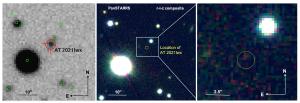Blog
Scary Barbie
28 April 2023
 NASA/CXC/U. Michigan/J. Miller et al.; Illustration: NASA/CXC/M. Weiss
NASA/CXC/U. Michigan/J. Miller et al.; Illustration: NASA/CXC/M. WeissIt’s a tale as old as time. A cataclysmic event occurs in the universe and releases a tremendous amount of energy in a short period of time. The event then fades into the darkness and the cosmos returns to normal. These short-lived cosmic events are known as transients and include things such as supernovae and gamma-ray bursts. Transients are quite common, but some of them can challenge explanations. Take for example the transient known as ZTF20abrbeie, nicknamed Scary Barbie.
Scary Barbie was first observed in 2020 and was later observed over a range of wavelengths. It’s an unusual transient for two reasons. The first is that it has lasted much longer than typical transients. A fast radio burst can last for seconds. The afterglow of a supernova can be observed for a month, but Scary Barbie has lasted for more than 800 days and continues to be visible. The second is how terrifyingly energetic it is. A supernova can outshine a galaxy, but Scary Barbie is a thousand times more energetic than the brightest supernovae. It’s hard to imagine the scale of this transient.
According to a study being published in The Astrophysical Journal Letters there’s really only one phenomenon that could explain Scary Barbie: A star being consumed by a black hole.1 Black holes don’t swallow stars whole. They first rip the star apart in what is known as a tidal disruption event (TDE). The superheated material of the star is captured by the black hole. Based on observations of ZTF20abrbeie, it was likely a TDE involving a 14 solar mass star and a supermassive black hole more massive than 100 million Suns.
 Subrayan, et al
Subrayan, et alOne of the strange things about this transient is that it doesn’t seem to be associated with a particular galaxy. That’s unusual since supermassive black holes tend to lurk in galactic centers. But then again, this transient is so unusual it wasn’t immediately recognized. The team only discovered it through an AI software package they developed known as the Recommender Engine For Intelligent Transient Tracking (REFITT). REFITT combs through observational data looking for transients to study. It came across Scary Barbie in public data from Palomar Observatory’s Zwicky Transient Facility. Once they discovered it, the team then gathered data from other observatories.
This work is a great example of how public data and AI data mining can lead to unexpected discoveries. Only by making data publically accessible and developing tools to filter through this information are these discoveries possible. Science works best when everyone can participate, as this latest study shows. Who knows what other amazing things are lurking in public data just waiting to be discovered?
Subrayan, Bhagya M., et al. “Scary Barbie: An Extremely Energetic, Long-Duration Tidal Disruption Event Candidate Without a Detected Host Galaxy at z= 0.995.” arXiv preprint arXiv:2302.10932 (2023). ↩︎